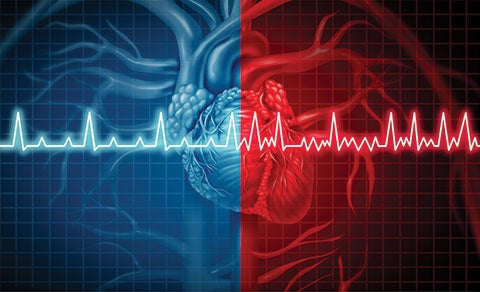
Atrial fibrillation is an abnormal heart rhythm characterised by rapid and irregular beating of the heart. It occurs more commonly as age increases.
Atrial fibrillation is the most common abnormal heart rhythm that affects millions in the world. While it can occur in individuals of any age, it tends to be more prevalent among the elderly. Those afflicted with atrial fibrillation face a five-fold increase in risk of stroke, due to the possibility of blood clots formation within the heart. Apart from the risk of stroke, the condition also makes one’s heart feel like it is racing, creating an uncomfortable and uneasy feeling. If poorly controlled, this may lead to weakening of the heart.
 | |
“Atrial fibrillation will go away on its own and treatment is not needed.” | The incidence of atrial fibrillation increases with age and in most patients, atrial fibrillation tends to be progressive. Other conditions such as high blood pressure, diabetes or stroke also occur with increasing age and are also risk factors for the development of stroke in patients with atrial fibrillation. Thus, in the majority of patients with atrial fibrillation, treatment becomes more important with time. The main goals of treatment include reducing stroke risk with blood thinners and controlling atrial fibrillation with medication or procedures. |
“I have atrial fibrillation but feel absolutely well. Hence, I am not at increased risk of stroke.” | It has been estimated that 40 percent of patients with atrial fibrillation do not experience any symptoms at all and they do not know that they have atrial fibrillation. The risk of stroke is increased in atrial fibrillation regardless of whether it causes any discomfort. In fact, a significant proportion of patients are unfortunately diagnosed with atrial fibrillation only after a stroke occurs because they were never aware of it prior. |
“I can’t drive or engage in physical exercise if I have atrial fibrillation.” | People with atrial fibrillation can continue to drive and exercise if their condition is controlled and if they are not prone to fainting. In fact, people with atrial fibrillation should continue to exercise to maintain a healthy lifestyle. |
“I can only depend on surgery or pacemakers to treat atrial fibrillation for good.” | Some people are under the impression that atrial fibrillation can only be treated with surgery or pacemakers, and are hence understandably hesitant to come forward to receive treatment. Atrial fibrillation can be managed with medication to restore a normal heart rhythm or gain control of the fast heart rates when it occurs. Blood thinners are commonly prescribed to prevent stroke. Your doctor, however, may also recommend procedures such as catheter ablation, which has been proven to be more effective in controlling atrial fibrillation than medication alone. |
“Taking blood thinners for atrial fibrillation puts me at unacceptable risk of bleeding.” | It is natural to be concerned about the side effects of medication. The risk of bleeding from taking blood thinners is low with the current blood thinners available, compared to older formulations. The risk of serious bleeding is estimated to be about 1% a year. Your doctor will recommend blood thinners if the risk of stroke outweighs the risk of bleeding. Preventing stroke is of great importance as stroke arising from atrial fibrillation tend to be more severe. |
Atrial fibrillation is usually progressive and often needs lifelong therapy. Besides seeking treatment early, there are ways to manage the condition, to slow down or stop the progression. In addition to seeking treatment, other ways to help include:
Quit smoking
Abstain from alcohol intake or reduce it as much as possible
Lose weight and try to achieve a healthy BMI (between 18.5 to 22.9 kg/m2)
Aim for good control of high blood pressure, cholesterol and diabetes if these conditions are present
Maintain an exercise routine with 30 minutes of moderateintensity aerobic exercise, 5 times a week and gradually increase this to 300 minutes a week.
A video version of the contents on how Dr Julian Tay, Assoc Consultant, Department of Cardiology, debunked myths on atrial fibrillation is available here.
This article is from Murmurs Issue 46. Click here to read other articles or issues.













 Get it on Google Play
Get it on Google Play